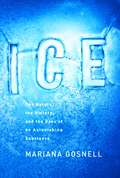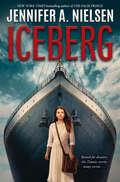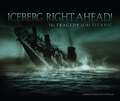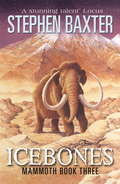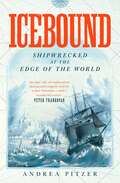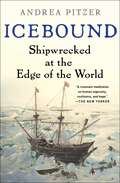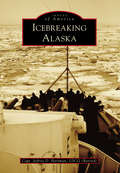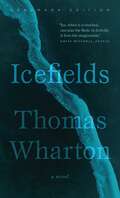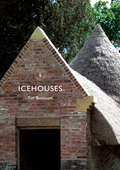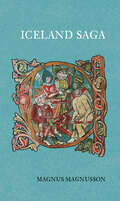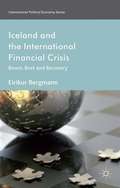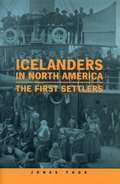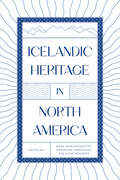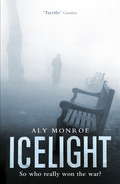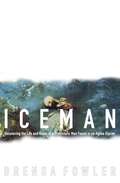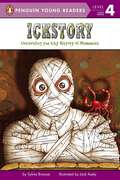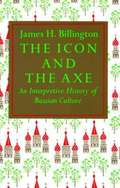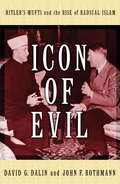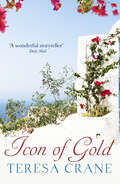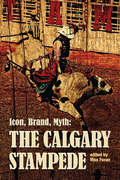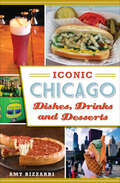- Table View
- List View
Ice: The Nature, the History, and the Uses of an Astonishing Substance
by Mariana GosnellLike the adventurer who circled an iceberg to see it on all sides, Mariana Gosnell, former Newsweek reporter and author of Zero Three Bravo, a book about flying a small plane around the United States, explores ice in all its complexity, grandeur, and significance.More brittle than glass, at times stronger than steel, at other times flowing like molasses, ice covers 10 percent of the earth's land and 7 percent of its oceans. In nature it is found in myriad forms, from the delicate needle ice that crunches underfoot in a winter meadow to the massive, centuries-old ice that forms the world's glaciers. Scientists theorize that icy comets delivered to Earth the molecules needed to get life started, and ice ages have shaped much of the land as we know it.Here is the whole world of ice, from the freezing of Pleasant Lake in New Hampshire to the breakup of a Vermont river at the onset of spring, from the frozen Antarctic landscape that emperor penguins inhabit to the cold, watery route bowhead whales take between Arctic ice floes. Mariana Gosnell writes about frostbite and about the recently discovered 5,000-year-old body of a man preserved in an Alpine glacier. She discusses the work of scientists who extract cylinders of Greenland ice to study the history of the earth's climate and try to predict its future. She examines ice in plants, icebergs, icicles, and hail; sea ice and permafrost; ice on Mars and in the rings of Saturn; and several new forms of ice developed in labs. She writes of the many uses humans make of ice, including ice-skating, ice fishing, iceboating, and ice climbing; building ice roads and seeding clouds; making ice castles, ice cubes, and iced desserts. Ice is a sparkling illumination of the natural phenomenon whose ebbs and flows over time have helped form the world we live in. It is a pleasure to read, and important to read--for its natural science and revelations about ice's influence on our everyday lives, and for what it has to tell us about our environment today and in the future.From the Hardcover edition.
Iceberg
by Jennifer A. NielsenAs disaster looms on the horizon, a young stowaway onboard the Titanic will need all her courage and wits to stay alive. A thrilling tale from New York Times bestselling author Jennifer A. Nielsen!Hazel Rothbury is traveling all alone from her home in England aboard the celebrated ship Titanic. Following the untimely death of her father, Hazel’s mother is sending her to the US to work in a factory, so that she might send money back home to help her family make ends meet.But Hazel harbors a secret dream: She wants to be a journalist, and she just knows that if she can write and sell a story about the Titanic's maiden voyage, she could earn enough money to support her family and not have to go to a sweatshop. When Hazel discovers that mother didn’t send her with enough money for a ticket, she decides she must stow away onboard the storied ship.With the help of a porter named Charlie and a sweet first-class passenger named Sylvia, Hazel explores the opulent ship in secret, but a haunting mystery quickly finds her. The danger only intensifies when calamity strikes, and readers will be caught up in the terror and suspense alongside Hazel as she fights to save her friends and herself.Bestselling author Jennifer A. Nielsen weaves an extraordinary tapestry of survival and disaster in this magnificent thriller.
Iceberg, Right Ahead!: The Tragedy of the Titanic (Single Titles Ser.)
by Stephanie Sammartino McPherson"Iceberg, Right Ahead!" Only 160 minutes passed between the time a sailor on lookout duty uttered these chilling words and the moment when the mighty ocean liner Titanic totally disappeared into the cold, dark waters of the North Atlantic. This century-old tragedy, which took more than 1,500 lives, still captivates people in the twenty-first century. Seventy-three years separate the two major Titanic events—the 1912 sinking of the vessel and the dramatic 1985 discovery of the wreck by Robert Ballard. But additional stories about the victims, survivors, rescuers, reporters, investigators, and many others show the far-reaching effects this tragedy had on society. Award-winning author Stephanie Sammartino McPherson has collected numerous personal accounts of the event, including the knighted man who spent the rest of his life in seclusion because he was accused of dishonorable behavior in a lifeboat, the stewardess who survived two shipwrecks and a mid-ocean collision, and the New York Times executive who sent multiple reporters to meet the rescue ship, thus earning a national reputation for his newspaper. She also links the Titanic tragedy to changes in regulations worldwide. After a Senate Inquiry and a British trial attempted to assign blame for the disaster, new laws on ship safety were put in place. A group of nations also banded together to form an ice patrol, eventually leading to the formation of the U.S. Coast Guard. Even the most avid Titanic fans will learn something new as McPherson brings the reader up to date on the politics and intrigue still surrounding the wreck—including what modern science can reveal about what really happened to the ship and who was at fault. Prepare to follow the never-ending story of the Titanic into its second century.
Icebones
by Stephen BaxterDetailed research, empathy with his characters, an ecological perspective and his trademark flare for epic narrative sweep make Baxter's Mammoth series very much key works in his canon.ICEBONES takes the action to a stunningly realised partially terraformed Mars in the far future and sees the epic Mammoth story cycle come to fruition.
Icebones
by Stephen BaxterDetailed research, empathy with his characters, an ecological perspective and his trademark flare for epic narrative sweep make Baxter's Mammoth series very much key works in his canon.ICEBONES takes the action to a stunningly realised partially terraformed Mars in the far future and sees the epic Mammoth story cycle come to fruition.
Icebound: Shipwrecked At The Edge Of The World
by Andrea Pitzer'An epic tale of exploration, daring and tragedy told by a fine historian - and a wonderful writer' Peter Frankopan, author of the bestselling The Silk Roads. A dramatic and compelling account of survival against the odds from the golden Age of Exploration. Since its beginning, the human story has been one of exploration and survival - often against long odds. The longest odds of all might have been faced by Dutch explorer William Barents and his crew of fifteen, who on Barents&’ third journey into the Far Arctic in the year 1597 lost their ship to a crush of icebergs and, with few weapons and dwindling supplies, spent nine months fighting off ravenous polar bears, gnawing cold and seemingly endless winter. This is their story. In Icebound, Andrea Pitzer combines a movie-worthy tale of survival with a sweeping history of the period - a time of hope, adventure and seemingly unlimited scientific and geographic frontiers. At the story&’s centre is William Barents, one of the sixteenth century&’s greatest navigators, whose larger-than-life ambitions and obsessive quest to find a path through the deepest, most remote regions of the Arctic ended in both catastrophe and glory - glory because the desperation that his men endured had an epic quality that would echo through the centuries as both warning and spur to polar explorers. In a narrative that is filled with fascinating tutorials - on such topics as survival at twenty degrees below, the degeneration of the human body when it lacks Vitamin C, the history of mutiny, the practice of keel hauling, the art of celestial navigation and the intricacies of repairing masts and building shelters - the lesson that stands above all others is the feats humans are capable of when asked to double then triple then quadruple their physical capacities.
Icebound: Shipwrecked at the Edge of the World
by Andrea PitzerIn the bestselling tradition of Hampton Sides&’s In the Kingdom of Ice, a &“gripping adventure tale&” (The Boston Globe) recounting Dutch polar explorer William Barents&’ three harrowing Arctic expeditions—the last of which resulted in a relentlessly challenging year-long fight for survival.The human story has always been one of perseverance—often against remarkable odds. The most astonishing survival tale of all might be that of 16th-century Dutch explorer William Barents and his crew of sixteen, who ventured farther north than any Europeans before and, on their third polar exploration, lost their ship off the frozen coast of Nova Zembla to unforgiving ice. The men would spend the next year fighting off ravenous polar bears, gnawing hunger, and endless winter. In Icebound, Andrea Pitzer masterfully combines a gripping tale of survival with a sweeping history of the great Age of Exploration—a time of hope, adventure, and seemingly unlimited geographic frontiers. At the story&’s center is William Barents, one of the 16th century&’s greatest navigators whose larger-than-life ambitions and obsessive quest to chart a path through the deepest, most remote regions of the Arctic ended in both tragedy and glory. Journalist Pitzer did extensive research, learning how to use four-hundred-year-old navigation equipment, setting out on three Arctic expeditions to retrace Barents&’s steps, and visiting replicas of Barents&’s ship and cabin. &“A resonant meditation on human ingenuity, resilience, and hope&” (The New Yorker), Pitzer&’s reenactment of Barents&’s ill-fated journey shows us how the human body can function at twenty degrees below, the history of mutiny, the art of celestial navigation, and the intricacies of building shelters. But above all, it gives us a firsthand glimpse into the true nature of courage.
Icebreaking Alaska
by Capt. Jeffrey Hartman UscgThe Arctic is a place of great challenges and great rewards. A century ago, it was whale oil; today, it is motor oil. The increasing open water in the warmer months is attracting cruise ships to tour the Arctic. Significant offshore oil and natural gas deposits are of great interest to an oil-dependent economy. But the history of the Arctic is full of surprises for the unwary and the unprepared, despite native peoples having managed to live there for thousands of years. Oil spills or maritime emergencies can--and do--arise a long way off from assistance. Legendary Arctic storms are, if anything, becoming more intense and dangerous. All this is in an area inaccessible by roads or by sea except for icebreakers the majority of the year. It is of extreme interest to the US Coast Guard, charged with protecting seafarers, enforcing laws, and facilitating commerce.
Icefields: Landmark Edition
by Thomas WhartonIn 1898, Doctor Edward Byrne slips on the ice of the Arcturus glacier in the Canadian Rockies and slides into a crevasse, wedged upside down nearly sixty feet below the surface. As he fights losing consciousness, a stray beam of sunlight illuminates the ice in front of him and Byrne sees something in the blue-green radiance that will forever link him to the ancient glacier. In this moment, his life’s purpose becomes uncovering the mystery of the icefield that almost was his tomb. Along the way, he encounters similarly fixated individuals, each immersed in their own quest: the healer and storyteller Sara; the bohemian travel writer Freya Becker; the entrepreneur Trask; the poet Hal Rowan; and Elspeth, greenhouse keeper and Byrne's lover.First published in 1995, Wharton’s Icefields is an astonishing historical novel set in a mesmerizing literary landscape, one that is constantly being altered by the surging and retreating glacier and unpredictable weather. Here—where characters are pulled into deep chasms of ice as well as the stories and histories they tell one another—is a vivid, daring, and crisply written book that reveals the human spirit, loss, myth, and elusive truths.This updated Landmark Edition includes an author interview with Smaro Kamboureli and an Afterword by award-winning writer Suzette Mayr.
Icehouses
by Tim BuxbaumIn the days before refrigeration, the very wealthy would use specially designed icehouses to store food from one season to the next. This book examines the design and development of icehouses, using many illustrations to explain how they worked and how they improved as scientific knowledge increased. With a detailed description of the different uses of icehouses, as well as examples of some of the most elaborately decorative structures, this book provides a rare insight into an intriguing subject.
Iceland Saga
by Magnus MagnussonMagnus Magnusson relates the world-famous Icelandic sagas to the spectacular living landscapes of today, taking the reader on a literary tour of the mountains, valleys, and fjords where the heroes and heroines of the sagas lived out their eventful lives. He also tells the story of the first Viking settler, Ingolfur Anarson.
Iceland and the International Financial Crisis
by Eirikur BergmannEirikur Bergmann explains the exceptional case of Iceland's fantastical boom, bust and rapid recovery after the Crash of 2008 and explores the lessons for the wider EU crisis and for over-reaching economies that over-rely on financial markets.
Icelanders in North America: The First Settlers
by Jonas ThorDuring the late 19th and early 20th centuries, thousands of Icelanders emigrated to both North and South America. Although the best known Icelandic settlements were in southern Manitoba, in the area that became known as ìNew Iceland,î Icelanders also established important settlements in Brazil, Minnesota, Utah, Wisconsin, Washington, Saskatchewan, and Nova Scotia. Earlier accounts of this immigration have tended to concentrate on the history of New Iceland.Using letters, Icelandic and English periodicals and newspapers, census reports, and archival repositories, Jonas Thor expands this view by looking at Icelandic immigration from a continent-wide perspective. Illustrated with maps and photographs, this book is a detailed social history of the Icelanders in North America, from the first settlement in Utah to the struggle in New Iceland.
Icelandic Heritage in North America
by Birna Arnbjörnsdóttir, Höskuldur Thráinsson and Úlfar BragasonA celebration of cultural inheritance and the evolution of language. Mapping the language, literature, and history of Icelandic immigrants and their descendants, this collection, translated and expanded for English-speaking audiences, delivers a comprehensive overview of Icelandic linguistic and cultural heritage in North America. Drawn from the findings of a three-year study involving over two hundred participants from Manitoba, North Dakota, Saskatchewan, and the Pacific West Coast, Icelandic Heritage in North America reveals the durability and versatility of the Icelandic language. Editors Birna Arnbjörnsdóttir, Höskuldur Thráinsson, and Úlfar Bragason bring together a range of interdisciplinary scholarship to investigate the endurance of the “Western Icelander.” Chapters delve into the literary works of Icelandic immigrant writers and interpret archival letters, newspapers, and journal entries to provide both qualitative and quantitative linguistic analyses and to mark significant cultural shifts between early settlement and today. Icelandic Heritage in North America offers an in-depth examination of Icelandic immigrant identity, linguistic evolution, and legacy.
Icelight: Peter Cotton Thriller 3: Gripping espionage at its best
by Aly MonroeBook 3 in the Peter Cotton spy thriller series, for fans of John le Carré and Robert Harris.Winner of the 2012 Ellis Peters Historical Fiction AwardPraise for Aly Monroe'Splendid . . .Monroe provides terrific and convincing historical atmosphere' The Times'Skilful and evocative . . . [a] stylish and impressive debut' The Economist1947. Threadbare London endures the bleakest, coldest winter for decades. Food rationing is worse than during the war. Coal supplies run out. The Thames freezes over. Against a background of black ice, blackouts and the black market, agent Peter Cotton is seconded to Operation Sea-snake. MI5 is in the grip of civil war; MI6 is riddled with traitors. Unsure who to trust - or even who is pulling the strings - Cotton, ever the outsider, must protect an atomic scientist caught up in a vicious homophobic witch-hunt, limit the damage caused by a bully-boy MP, rely on a rent-boy informer and, despite the murderous attentions of a couple of Glasgow razor boys, embark on a ruthless hunt of his own.The Peter Cotton spy thriller series:Book 1: The Maze of CadizBook 2: Washington ShadowBook 3: IcelightBook 2: Black BearShort story: Redeemable
Icelight: Peter Cotton Thriller 3: Gripping espionage at its best (Peter Cotton Ser.)
by Aly MonroeWinner of the 2012 Ellis Peters Historical Fiction Award, ICELIGHT is the third in the critically acclaimed Peter Cotton series following the fortunes of British spy Peter Cotton as he navigates the treacherous uncertainties of the post-war world. For all fans of John le Carre, Robert Harris, Eric Ambler and Graham Greene.'Confirms Aly Monroe's genius for creating tension' Daily Telegraph 1947. Threadbare London endures the bleakest, coldest winter for decades. Food rationing is worse than during the war. Coal supplies run out. The Thames freezes over. Against a background of black ice, blackouts and the black market, agent Peter Cotton is seconded to Operation Sea-snake. MI5 is in the grip of civil war; MI6 is riddled with traitors. Unsure who to trust - or even who is pulling the strings - Cotton, ever the outsider, must protect an atomic scientist caught up in a vicious homophobic witch-hunt, limit the damage caused by a bully-boy MP, rely on a rent-boy informer and, despite the murderous attentions of a couple of Glasgow razor boys, embark on a ruthless hunt of his own.
Iceman: Uncovering the Life and Times of a Prehistoric Man Found in an Alpine Glacier
by Brenda FowlerOn a warm September day in 1991, two German hikers stumbled upon a frozen, intact body melting out of the remains of a glacier in the Tyrolean Alps. Over the next few days, as a parade of often irreverent visitors poked and prodded the mummy-like corpse, curious items began to emerge from the ice: an ax with a metal blade, a longbow, finely stitched leather clothing, and--most astonishing of all--boots stuffed with grass. But only after the corpse was recovered and taken for an autopsy to the medical examiner in Innsbruck, Austria, did a vigilant archaeologist recognize that this was no ordinary dead body. Iceman is the story of the international scientific investigation launched to study the world's oldest naturally preserved human corpse and the astounding cache of prehistoric personal effects found with it. The dramatic narrative takes us from the day of the Iceman's discovery through eight years of scientific investigation, political intrigue, bizarre theories, and ravenous media coverage. The product of more than one hundred interviews with researchers in Austria, Italy, and Germany,Iceman follows scientists into labs and archaeologists into the field as they search for clues to the life and times of a man who lived before the advent of writing and cities. Who was he? Why were parts of his equipment damaged and unfinished? Where was he going? How did he die? Iceman is not merely a compendium of data but the story of the forces that produced and shaped them. At times, debates over who owned the Iceman and what should be done with him overshadowed the research. Brenda Fowler chronicles the scientists' squabbles and ego trips and the unexpected twists in the research, including the claim that the Iceman was a fraud and the mystery of his missing penis. Along the way, the authority of science is powerfully questioned and then, largely, reaffirmed in a surprise ending that has already led to a reexamination of the Iceman's final hours and his five millennia in the ice.
Ich spioniere einen Herzog aus (Geheime Erbinnen #1)
by Erica MonroeSIE WILL RACHE Als die gebildete Vivian Loren die Gouvernante der reichen Spencer Familie wird, ist sie zwar auf der Jagd nach Hinweisen über den Mord an ihrem Bruder, aber nicht nach einer Romanze. Allerdings hat Vivian mit einer Sache nicht gerechnet: James Spencer, dem furchtlosen Herzog von Abermont, der selbst eine quälende Vergangenheit hat. ER BRAUCHT EINE EHEFRAU Als führender Kopf des Britischen Geheimdienstes, kann sich James nicht leisten vom Heiratsmarkt durchleuchtet zu werden, sobald die Hochzeits- und Ballsaison beginnt. Nachdem er Vivians Wunsch nach Rache entdeckt, wird sie zu einem Pfand in einem heimtückischen Komplott, ausgeheckt von einem der gefährlichsten Spione Napoleons. James realisiert schnell, dass sie sich gegenseitig helfen können. Vivian soll seine Herzogin werden und im Gegenzug würde er sie beschützen. Was als Heirat einer Zweckgemeinschaft beginnt wird rasch mehr, aber der feindliche Spion kommt den beiden gefährlich nah. Wenn Ehemann und Gattin beide dunkle Geheimnisse haben, wird die Liebe rasch zur gefährlichsten Mission von allen.
Ick! Yuck? Eew!: Our Gross American History
by Lois Miner HueyKids study US history, but do they know what life long ago was really like? The past was full of yuckiness. The sounds, smells, filth, bugs, rats, poor hygiene, lack of dental and medical care, and bad food are not portrayed at today's historic sites, in movies, or in most books about US history. Yet this kind of stuff appeals greatly to kids.
Ickstory: Unraveling the Icky History of Mummies (Penguin Young Readers, Level 4)
by Sylvia BranzeiThe creators of Grossology continue the icky, sticky history lesson with this reader about mummies from around the world. With hilarious illustrations and disgusting facts about mummies, this Level 4 reader will keep readers wrapped up for hours!
Icon and Axe
by James Billington"A rich and readable introduction to the whole sweep of Russian cultural and intellectual history from Kievan times to the post-Khruschev era." - Library Journal. Illustrations, references, index.From the Trade Paperback edition.
Icon of Evil: Hitler's Mufti and the Rise of Radical Islam
by David G. Dalin John F. RothmannDalin (Hoover Institution, Stanford U. ) and Rothmann (Fromm Institute, U. of San Francisco) tell the story of Haj Amin al-Husseini, the one-time mufti of Jerusalem, and his support for the fascists during World War II. In the long-standing debate concerning whether Husseini's activities were driven by anti-Semitic hatred as opposed to anti-Zionism/Palestinian nationalism, they opt decisively for the former. Most of their discussion of Husseini's fascist activities will be relatively uncontroversial, although it's quite clear that when faced with choices of interpretation they are far more likely to chose the one that paints the mufti in a bad light, but their argument gets significantly weaker as they attempt to intimately connect Husseini to virtually every single opponent of the US and Israel in the Middle East including the Palestinian Liberation Organization, Saddam Hussein, Al-Qaeda, Hezbollah, and Hamas. Annotation ©2008 Book News, Inc. , Portland, OR (booknews. com)
Icon of Gold
by Teresa CraneA searing tale of forbidden love spanning 1950s Britain and Greece from the author of A Fragile Peace, &“a wonderful storyteller&” (Daily Mail). Cathy Kotsikas is as unsettled as anyone in postwar Britain. A hasty marriage has become an exhausting clash of personalities. Leon, her Greek husband, as charming as he is ruthless and self-centered, understands neither her mildly eccentric character nor her need for freedom. Cathy&’s sanctuary is Sandlings, a remote cottage on the barren Suffolk coast left to her by her grandfather. For Leon, however, his business in London and the restoration of his family home in Greece are of paramount importance. When Nikos, Leon&’s son, arrives from New York, he is drawn to Cathy from the first, and she to him. Neither sees the danger of the attraction until it is too late. Their chemistry becomes a spiral of passion and betrayal culminating in the wild sunlit beauty of the Greek countryside. But how will it end . . . ? &“A story with great momentum and the added attraction of inviting backdrops in sunlit Greece and a remote seascape in Suffolk.&” —Liverpool Echo &“A writer of great skill and vitality.&” —Sarah Harrison, international bestselling author of The Flowers of the Field
Icon, Brand, Myth: The Calgary Stampede
by Max ForanAn investigation of the meanings and iconography of the Stampede: an invented tradition that takes over the city of Calgary for ten days every July. Since 1923, archetypal "Cowboys and Indians" are seen again at the chuckwagon races, on the midway, and throughout Calgary. Each essay in this collection examines a facet of the experience--from the images on advertising posters to the ritual of the annual parade. This study of the Calgary Stampede as a social phenomenon reveals the history and sociology of the city of Calgary and the social construction of identity for western Canada as a whole.
Iconic Chicago Dishes, Drinks and Desserts (American Palate Ser.)
by Amy BizzarriA celebration of Chicago food that goes far beyond deep-dish pizza—filled with recipes, photos, and local history! The food that fuels hardworking Chicagoans includes such local classics as Spinning Salad, Flaming Saganaki, Jumpballs, Jim Shoes, Pizza Puffs, and Pullman Bread. The restaurants, bakeries, taverns, and pushcarts of the city, cherished from one generation to the next, offer satisfying warmth in winter and sweet refreshment in summer. From the city that created the Cape Cod Room&’s Bookbinder Soup and the Original Rainbow Cone, as well as Andersonville Coffee Cake and Taylor Street&’s Italian Lemonade, this combination of cookbook and culinary history is a treat for Chicagoans, visitors, and anyone who loves hearty Midwestern fare.
